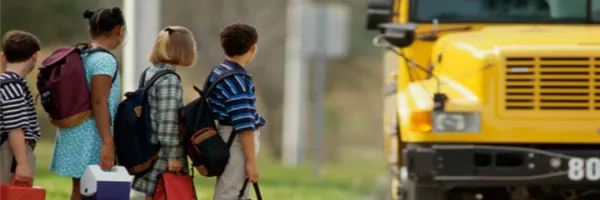
Get Ready for the Back-to-School Zone
As summer winds down and students head back to school, more than half of them will do so in private cars (Safe Routes to School). Since parents driving their children to school generate an estimated 21% of total morning traffic, everyone on the road during this time will be affected, whether or not you’re making a trip to school yourself.
With school buses returning to the roads and many communities seeing more children than ever cycling and walking to school, it’s essential to make sure you know how to drive safely in school zones and around school buses. Plus, knowing and following the laws can save you a bundle - traffic violations committed in school zones often have especially high fines!
Stay Alert in School Zones
Slow Down
- When you enter a school zone, make sure to reduce your speed, which allows you to stop in a shorter distance to avoid a collision. (Safe Routes to School).
- Slower speeds also dramatically reduce the chance of pedestrian injury or death in the event of a collision. (Safe Routes to School)
- School zone speed limits vary, so check with your state’s department of motor vehicles to find out standard speed limits, and always obey the posted speed limit for each school zone you drive through.
Watch for Children
- Children are the least predictable pedestrians and the hardest to see. Children may take risks such as darting out into the street without looking for traffic, especially in familiar surroundings like the streets around their home or school.
Keep Crosswalks and Streets Clear
- Avoid double parking to drop off children. This blocks visibility for other children and motorists in the area, who may not be able to see cars or pedestrians behind your car. (Safe Routes to School)
- Do not block crosswalks or stop with a portion of your vehicle over the crosswalk. This forces pedestrians to walk around the front of your car and closer to moving traffic, or behind your car where they are less visible.
Brush Up on School Bus Laws
Always Stop on an Undivided Road
- On an undivided roadway, all 50 states require traffic in both directions to stop when students are entering or exiting a school bus.
Check Your State’s Laws
- On divided roadways, all 50 states require traffic behind the school bus to stop, but state laws vary on whether traffic on the opposite side of the divided roadway must stop.
- To find out what your state requires, check the AAA Digest of Motor Laws.
Watch for Flashing Lights
- State laws also vary as to how drivers must respond to flashing signal lights on a school bus. Some states require that motorists stop whenever any signal lights are flashing, while others distinguish between yellow lights indicating that the bus is preparing to stop, and red lights which signal that children are entering or exiting the bus.
- Check your state’s laws in the AAA Digest of Motor Laws.
Illegal Passing
- Driving on the sidewalk or passing a school bus on the right to avoid having to stop and wait is illegal and extremely dangerous.
- While it can be a pain to get stuck behind a school bus, stopping and waiting until the bus turns its signal lights off is the only safe option.
Get Ready for Heavier Traffic
- Be prepared for changes in traffic patterns, and allow extra time to reach your destination.
- You can also consider planning your route to avoid school zones and school bus stops during the morning and afternoon.
- Be prepared to encounter more students walking and biking to or from schools or bus stops. Take the time to double check for children on sidewalks or in the street, especially at driveways and crosswalks, and review how to safely share the road with cyclists.
As always, avoid using your cell phone while driving and eliminate other distractions in your car so that you can give the task of driving your full attention.
For a visual explanation of how to safely share the road with school buses, check out the National Safety Council’s public service announcements for motorists and for parents helping their kids learn school bus safety.